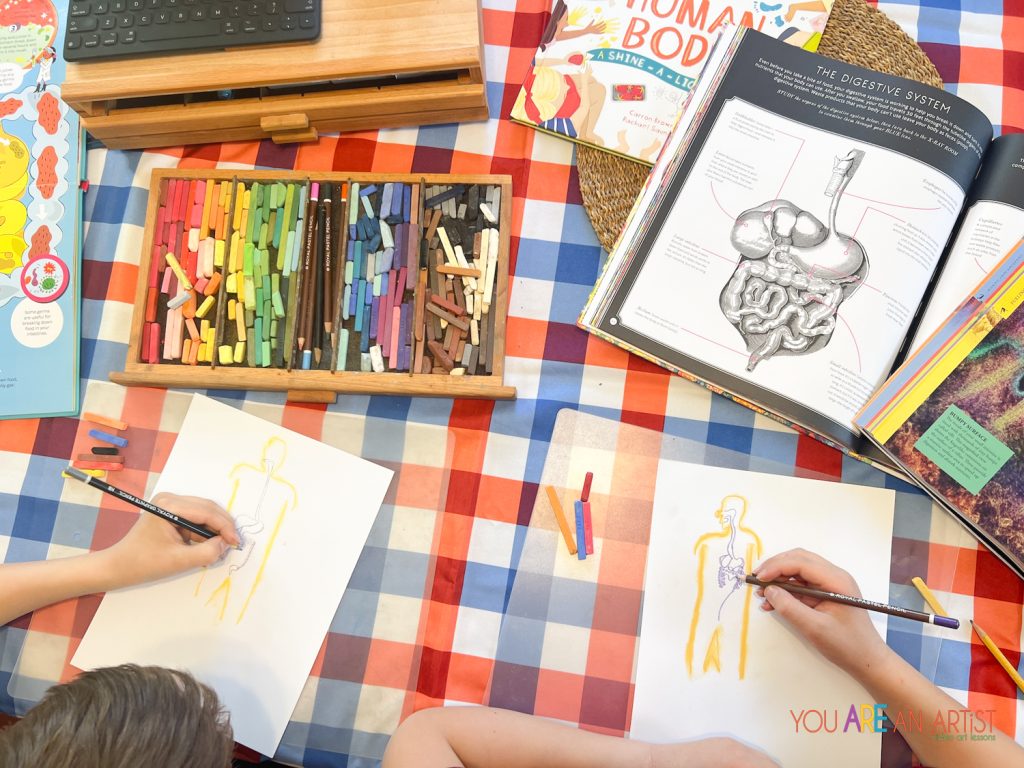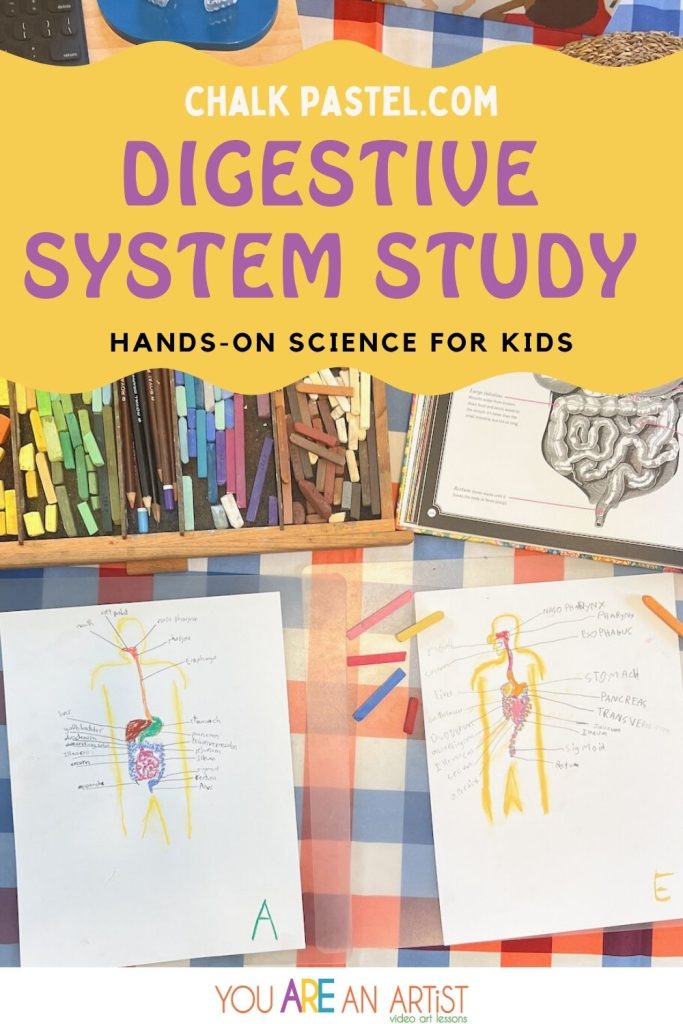Nana’s digestive system study lesson offers a hands-on homeschool activity that includes art, science, labeling, handwriting, and vocabulary building. So many ways to learn, all in one lesson!
The Power Of Art In Science
Kids generally love science because it can be so visual and tactile, as in the case of the natural sciences. Yet much of science explores realms of the unknown that are hidden from our eyes.
Some of these wondrous worlds are microscopic. While others are difficult to access for easy study, as in the case of the human body. Here we are, walking around as a living scientific specimen, but most of the beauty of human anatomy is internal! Unless your child will one day go to medical school, it is difficult to have a “hands-on” experience with the inner workings of the human body!

Art can be a valuable tool for understanding and exploring science topics, like human anatomy, that are not readily accessible to the casual scientist.
Through photographs, diagrams, and artwork, we’re able to explore the hidden mysteries of how our bodies are designed, and how the systems work. Also, let’s be honest, there are many parts of the human body that most of us would rather not touch and explore in reality!
From zooming in on microscopic cells, to the intricate parts of the heart or ear, art gives us access to learning these hard-to-picture body systems. And, it removes the gross-out factor some of us experience!
Beyond access, art just makes learning science FUN because it brings in a familiar, playful activity to the new content! Kids of all ages can pick up a stick of chalk and outline the basic elements of the eye or the digestive system.
Because art helps kids experience science in such a tactile way at their readiness level, kids are more likely to retain the information because the learning becomes an experience, not just another “lesson.”
Digestive System Study For Kids
The other day, my son was resting his head on my stomach while I read a book aloud. Suddenly, he sat up and said, “Your stomach is very noisy!” It was a perfect opportunity to explain the digestive system at work!
Now, the human digestive system is one of these scientific topics that is not easy for kids to imagine. Plus it is quite complicated. So an art lesson is perfect for exploring the intricacies of this system. Nana with her delightful teaching style makes this detailed drawing accessible for kids. She even named the person she draws “Oscar.” This made my boys giggle!

First, Nana walked my boys step-by-step through drawing a body outline, and then filling in the path that food takes through the digestive system from the mouth to the rectum.
Along the way, Nana implements some chalk pastel techniques, like blending the outline of the body to give Oscar a “glow,” and the use of chalk pastel pencils to draw more intricate details.
While she’s demonstrating how to draw each part, she is naming and discussing some details about the relative size, shape, and location of the parts. Each part gets color-coded, and sometimes Nana will add a little detail, such as how the colon carries waste out of the body.

Afterward, she labels each part, so kids get a second chance to learn the names of the parts. If your student is too young for this labeling work, they could just repeat after her, or you as the parent could write in the parts. It might be helpful to pause the video to allow students to keep up, or to have a printed list of parts they can look at for correct spelling. This practice of scientific labeling is a great foundation for future science note booking or developing good study habits.
A great follow up to this lesson would be to get some books on the digestive system, and learn what each part does! Or maybe complete this video art lesson after you’ve done some reading.

More Ideas For Hands On Science In Your Homeschool
Our family studies human anatomy about every other year, because it comes up in one of my son’s curriculum or the other. So it’s helpful to have a variety of ways to present some of the same information as the years progress.
We’ve been reading books and articles and watching YouTube videos on human anatomy. Drawing the systems and body parts with chalk pastel is the perfect next step in expressing their learning.
Here’s what I love about the Chalk Pastel I Drew It Then I Knew It series for education: you can use a video either to introduce a topic and generate excitement. Or, you can use a video post-reading or teaching to expand and solidify their learning. You can even do BOTH! Introduce a topic with a chalk pastel video, teach the content, and then ask your child to draw the picture again without the video as a post-learning assessment!
The chalk pastel video art lessons are so versatile, you can use them at any point in your lesson plans! I have been thrilled to see Nana offering an expanding catalog of lessons on the human body via the You ARE an Artist Clubhouse Membership.

If you’re also studying human anatomy or any aspect of the human body, you’ll love to know that Nana has a whole series of lessons and ideas for you:
The Diagram of the Heart lesson will surely get kids’ hearts pumping for more science learning!
And of course, who doesn’t love a good old “Mr. Bones” type study of the Skeletal System Activities for Kids?
If you want to really wow your kids about what’s happening beyond their vision, dive down into the microscopic world with the Diagram of a Cell.
You could follow that up with the Diagram of an Eye lesson to discuss how our eyesight works, and why it’s limited in scope.
Want them to really sink their teeth into science? Try these Tooth Diagram activities!
You’ll hear them cheer when you tell them they can draw a Diagram of the Ear!
Don’t forget that keeping your body healthy is so important! The Diagram of a Bacterium lesson can introduce kids to the microscopic ways our body takes care if itself and fights off invaders.
You can access all these vibrant art and science lessons and more with the You ARE an Artist Clubhouse Membership. Kids will never want to stop learning when they can paint as they grow their knowledge!


Julie is a teacher, writer and homeschool mom. Her blog Happy Strong Home shares encouragement for cherishing children, enjoying motherhood, and growing strong families. Discover homeschool resources, natural living tips, and family activity ideas. Julie has been featured on Million Praying Moms, The Old Schoolhouse Magazine, and the Melissa and Doug blog. She offers writing workshops and a “homeschool neighborhood” community to support parents in their homeschool adventures. Find Julie on Instagram to be the first to know when new workshops and community events are available.
